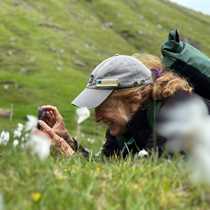Hells Canyon and the Clearwater River
It is probably best to start with an explanation of the inquisitive photo that accompanies this text. This morning half of our contingent from the Sea Lion boarded a jet boat to zip up the Snake River and explore about 60 miles into Hell's Canyon. This terraced rocky canyon is a refuge for re-introduced Rocky Mountain bighorn sheep. Numerous herds of sheep were found, each group numbering anywhere from eight to twelve individuals. This is rut season and multiple rams escorted the groups of ewes. We witnessed a jostling trio of rams at Heller Bar, the site of this photograph. Without doubt, there is strong hormonal chemistry stirring in the rams right now. Displays by rams included slow rolls of the head, allowing the potential opponent a good look at the impressive horns of the dominant male, a few chase sequences, which sent rocks bouncing down the cliff sides and an audible "konk" was heard as we watched two animals butt horns. The dominant animal was quite obvious to us, but sometimes with all these young rams about, it just needs to be re-affirmed.
Apparently it has been a wet fall; the normally brown hillsides wore a fresh carpet of green and the creases of the hillsides were filled with trees in autumn color. The fall palette ran the full spectrum from gleaming golds to fiery reds and the crisp air was an appropriate accompaniment.
Up the Clearwater River in the footsteps (and paw prints) of Lewis and Clark is where the other half of our guests explored. To call him our "guide" seems to understate the knowledge and the passion with which Linwood Laughy shares the history of the Corps of Discovery. History came to life as Lin took us from Saddle Cache to campsites in the hills and then down to river level at Canoe Camp. Lin's narrations put us in the moccasins of the Corps and took us on a virtual paddle downstream in the five new dugout canoes. You almost expected to see the Corps come paddling around the bend while you stood at rivers edge.
Our day's explorations ended with a visit to the Nez Perce Historical Site. Extension collections portraying Nez Perce foods, finery and photographs gave us an introduction to a people that could have easily changed the course of history. There are many "what if" questions that could be asked in reference to the Nez Perce and the Corps of Discovery. Had these people not been so gracious and sharing with the Expedition, we could easily have been visiting the last campsites of the Corps of Discovery, definitely a cause for pause and reflection.
It is probably best to start with an explanation of the inquisitive photo that accompanies this text. This morning half of our contingent from the Sea Lion boarded a jet boat to zip up the Snake River and explore about 60 miles into Hell's Canyon. This terraced rocky canyon is a refuge for re-introduced Rocky Mountain bighorn sheep. Numerous herds of sheep were found, each group numbering anywhere from eight to twelve individuals. This is rut season and multiple rams escorted the groups of ewes. We witnessed a jostling trio of rams at Heller Bar, the site of this photograph. Without doubt, there is strong hormonal chemistry stirring in the rams right now. Displays by rams included slow rolls of the head, allowing the potential opponent a good look at the impressive horns of the dominant male, a few chase sequences, which sent rocks bouncing down the cliff sides and an audible "konk" was heard as we watched two animals butt horns. The dominant animal was quite obvious to us, but sometimes with all these young rams about, it just needs to be re-affirmed.
Apparently it has been a wet fall; the normally brown hillsides wore a fresh carpet of green and the creases of the hillsides were filled with trees in autumn color. The fall palette ran the full spectrum from gleaming golds to fiery reds and the crisp air was an appropriate accompaniment.
Up the Clearwater River in the footsteps (and paw prints) of Lewis and Clark is where the other half of our guests explored. To call him our "guide" seems to understate the knowledge and the passion with which Linwood Laughy shares the history of the Corps of Discovery. History came to life as Lin took us from Saddle Cache to campsites in the hills and then down to river level at Canoe Camp. Lin's narrations put us in the moccasins of the Corps and took us on a virtual paddle downstream in the five new dugout canoes. You almost expected to see the Corps come paddling around the bend while you stood at rivers edge.
Our day's explorations ended with a visit to the Nez Perce Historical Site. Extension collections portraying Nez Perce foods, finery and photographs gave us an introduction to a people that could have easily changed the course of history. There are many "what if" questions that could be asked in reference to the Nez Perce and the Corps of Discovery. Had these people not been so gracious and sharing with the Expedition, we could easily have been visiting the last campsites of the Corps of Discovery, definitely a cause for pause and reflection.




